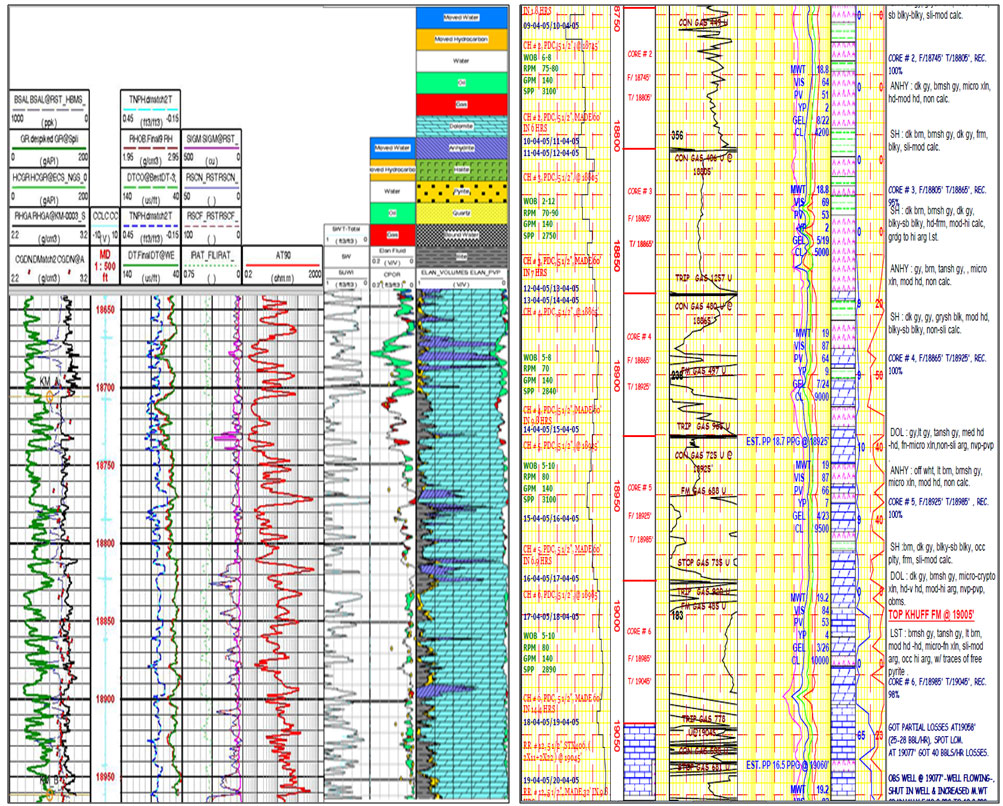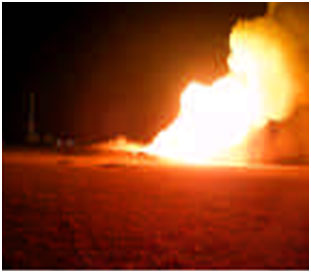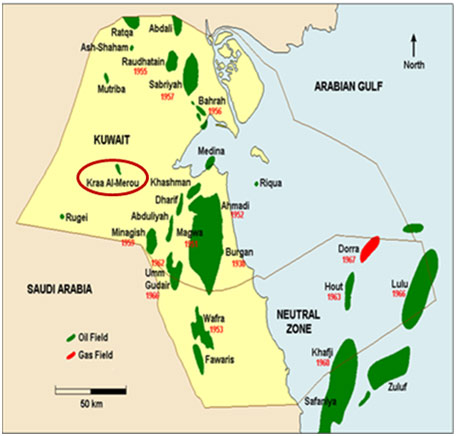Integrated Formation Evaluation of HPHT Tight Reservoirs, a case study from West Kuwait
Ahmed Rabie, Riyasat Husain, Musaed Al-mukhaizeem, and Abdulaziz Mohamed Al-Fares
Introduction
The exploratory efforts are focused on evaluation of non-conventional Paleozoic-Triassic reservoirs in frontier areas. Triassic reservoirs are emerging as important exploration target. Start 2002, Wells KM-B and MU-B in Kra Almaru and Mutriba structures were drilled to about 19,000 ft to investigate the non-conventional overpressure Lower Jilh Formation (Kra Almaru Unit/Early Triassic) reservoir, in the western part of Kuwait.These wells have flowed measured quantities of sweet gas and condensates from these reservoir to the surface.
This confirmed the presence very good hydrocarbon indications in the Triassic deep Formations and recorded a matrix porosity developed in carbonates below 19,000 ft.
Triassic Stratigraphy of Kuwait is represented by three formations - Sudair, Jilh and Minjur. In the western part of Kuwait an additional stratigraphic unit provisionally defined as ‘Kra Almaru is present in Lower Jilh Fm. between Sudair Fm. The Lower Jilh Formation (Kra Almaru Unit/Early Triassic) reservoir are overlain by Jurassic Najmaj / Sargelu / Marrat reservoirs and rest on the Upper Paleozoic Khuff Formation.
The reservoirs are characterized by a complex suite of rocks consisting of dolostones, limestones, anhydrites, shales and halite.
The challenges
- During the well testing operation of well KM-B, a high salinity water cut was recorded and the salt plugged the production tubing and impeded the production of any hydrocarbon, with Unknown source of water entry / salt plugging.It masked the interpretation of gas zone and it was difficult to determine the true rates from the well.
- Triassic reservoir quality is poor as porosity, permeability and pore-geometry are negatively affected by multiple diagenetic events and can easily go undetected by most logging tools which are mainly designed for conventional reservoirs.
- These complex fractured carbonate reservoirs containing volatile oil, and or gas and condensate at high temperature 300 degrees F, with high pressure over 19000 psi formation pressures at 20,000 feet, and with some H2S, small borehole design, use of oil based mud.
- Lack of cement isolation across the reservoir section.
Objectives
The objectives of the Integrated Formation re-evaluation are fresh evaluation of intervals with testing results to:
- Confirm the presence of potential hydrocarbon bearing intervals in the non-conventional Lower Jilh Formation (Kra Almaru Unit) reservoir.
- Identify the unknown source of the water & causes of salt plugging.
- Evaluate the field’s commercial potential.
- Recommendations for future analysis and data gathering, testing and stimulation.
Workflow
Innovative and integrated workflows incorporating well logs, core reports, gas chromatography, fracture, thin section petrography, well test and mud logging data have been employed. Drilling report review, Perforation analysis, Productivity Index, Maximum Production and Cement Evaluation have been integrated with the formation evaluation for identification and evaluation of these reservoirs.
The analysis has indicated formation damage due to overbalance drilling, production of both hydrocarbons and water from the reservoirs and better hydrocarbon potential in Kra Almaru. It is recommended to utilize LWD services especially EcosSope and sigma measurement to acquire the data prior to significant invasion. The synergistic workflows to be updated on continuous basis are a pre-requisite for exploration of these challenging reservoirs.
The scope of work to be conducted on two wells can be broken down as follows:
- Data Collection and QC
- Petrophysical Assessment:
- Log Data Preparation and loading
- Mud-log Review
- Core Data and Analysis
- Cementation Exponent correction
- Petrophysical lithology model
- Petrophysical interpretation parameters
- Formation Evaluation & petrophysical analysis
- Reservoir summation
- Production Analysis:
- Drilling report review
- Perforation analysis (SPAN software Analysis)
- Productivity Index PI (Pipesim software Analysis)
- Maximum Production (Nodal software Analysis)
- Cement Evaluation
- Unknown source of water entry
- Technical Integration of Petrophysical Interpretation and Well Testing Analysis
- Final Report
6 - Petrophysical Interpretation Results
The main requirement is the computation of effective porosity, shaliness and water saturation over the logged intervals. After correction, the data was loaded into the Interpretation Software.
The Lower Jilh formation (KM unit) was only encountered in the Mutriba and Kra Al-Maru fields and seemed to contain potential for hydrocarbon from core and mud log reports.
As a result the availability of the full suite of logs is limited due to hole stability and well control issues which implies that it is not possible to run the log analysis to calculate the porosity and hydrocarbon saturation. Unfortunately, the cement work behind the casing was very poor. However, in the lack of open hole log data, KM-B well evaluated by Cased Hole logs : RST and ECS to help determine porosity, lithology and saturation, in conjunction with core data, with high degree of uncertainty.
The result of the interpretation in the KM unit of the Lower Jilh of KM-B show a poor potential HC. This may be due to the fact that 70% 0f the KM-B well data were obtained from KM-A well assuming that both wells have the same properties and from cased hole data.
The result of the interpretation in the KM unit of the Lower Jilh of KM-B well is shown below:
 KM-B Petrophysical Evaluation in the Lower Jilh (KM Unit) and Mudlog.
KM-B Petrophysical Evaluation in the Lower Jilh (KM Unit) and Mudlog.
Conclusions
- The Lower Jilh Formation (KM-Unit) only seems to be developed in the fields Mutriba and Kra Al-Maru, where MU-B and KM- B are drilled.
- KM-B has poor quality cased-hole data. To conduct the analysis, several logs were re-constructed from well KM-A open-hole data.
- The analysis is indicative of formation damage due to overbalance drilling.
- The The test results of KM-B well in Lower Jilh Formation (KM Unit) show hydrocarbon (gas and condensate) produced initially.
- In the KM-B well, Salt accumulation is observed from the test and stopped the production in this formation, thereby requiring a special completion systems.
- It’s unable to identify, with any certainty, the source of the water production from Triassic reservoir.
- Low deliverability based on flow capacity evaluation (from logs and core) of the Lower Jilh formation (KM Unit), indicating that the actual produced fluid (both water and HC) were produced from KM-Unit.
Recommendations
- The synergistic workflows to be updated on continuous basis are a pre-requisite for exploration of these challenging reservoirs.
- Due to the unknown water source, water shut-off isolation by chemical treatment (permeability modifier) for the water zone and investigate the causes of salt plugging. (The source of the water production remains unknown)
- A production logging (PLT/RST) would be run prior to water shut off procedure and following the treatment.
- Then re-perforate the water free zone and re-complete the well for long term production test and stable gases production.
- Evaluate of the field’s commercial potential.
- It is recommended to utilize LWD services especially EcosSope and sigma measurement to acquire the data prior to significant invasion.
AAPG Search and Discovery Article #90135©2011 AAPG International Conference and Exhibition, Milan, Italy, 23-26 October 2011.

 Unnumbered Figure.
Unnumbered Figure. Unnumbered Figure.
Unnumbered Figure.